The 1986 accident at the Chernobyl nuclear power plant was one of the worst man-made catastrophes ever, and the worst event in the history of the Soviet Union other than the 1941 German invasion during WWII.
Quite improbably, a vehicle of that war played a very minor role in the 1986 event.
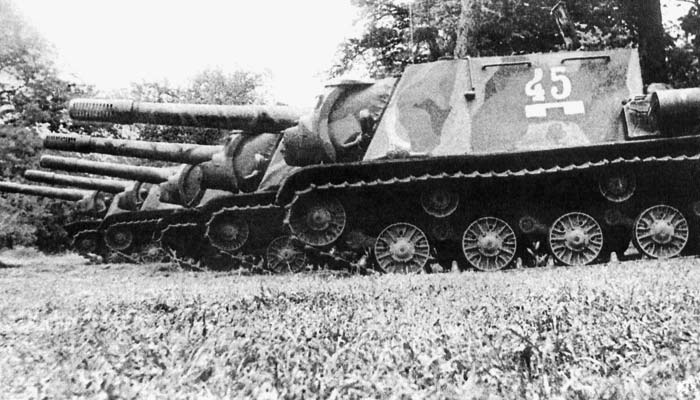
(ISU-152s of the Soviet army during WWII.)

(A German road sign points east towards Chernobyl during the “Barbarossa” operation in 1941.)

(Liquidators (cleanup workers) with a ISU-152 at the disaster in 1986.)
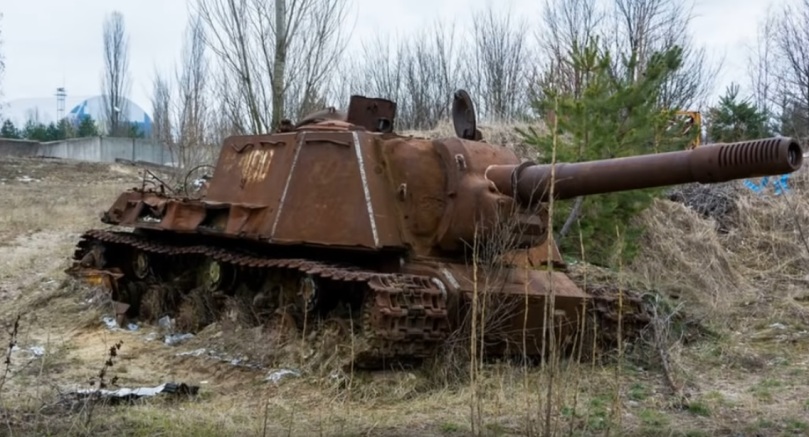
(ISU-152 in Pripyat, Ukraine during 2018, with the New Safe Containment (NSC) structure of the former Chernobyl nuclear power plant in the background.)
the area

(map via Bing)
The map above shows the immediate vicinity of the 1986 accident, with the power plant circled. Pripyat, where the power plant is actually located, was a new city built from scratch in 1970 specifically paired with the power plant. Pripyat was about 6 miles northeast of the actual town of Chernobyl, which none the less lent its name to the power plant and the disaster.
This region lays about 50 miles north of Kiev and just slightly south of today’s Belarus – Ukraine international border, which in 1986 was just an administrative line inside the Soviet Union. Today the aftermath of the disaster is considered a Ukrainian problem in popular culture; however; outside of the massively-contaminated local area, 70% of the radiation actually came down on what is today Belarus which has its own exclusion zone. Unlike Ukraine, Belarus maintains rigid security on its zone and has not fostered any sort of tourism industry there.
Chernobyl during WWII
The area around Chernobyl was occupied by Germany from 25 August 1941 – 17 November 1943.

During the 1941 German advance, Chernobyl did not see any fighting. However before they departed, the retreating Soviet army removed anything of use from the city and also blew the bridge over the Dnieper river. For whatever reason, agents of the NKVD (predecessor of the KGB) summarily executed every inmate in the city jail.

(This tree near the power plant was called “Partisans Tree” because locals said that during WWII, the Germans hanged Soviet partisans from it. The tree died from radiation in 1986 and fell over in 1996.)
The city did see fighting during the Soviet 13th Army and 60th Guard Army’s 1943 “Dnieper Frontal” operation. By mid-September 1943, Soviet 13th Army troops had ejected the Wehrmacht’s 4th Panzer Army from the east bank of the Dnieper river opposite Chernobyl. On 29 September, Soviet infantry established a beachhead on the west bank south of the city, which was now garrisoned by the 213th Sicherungs Division. One of the Wehrmacht’s “security divisions”, it was intended and set up to hold areas behind the frontlines, not to necessarily be on the front itself.

(The Wehrmacht battle plan for defending the southern flank of Chernobyl in 1943.)
For about two weeks, control of Chernobyl shifted back and forth between the Germans and Soviets. At one point, the Wehrmacht HQ unit was actually located on the spot to the north where the power plant would be built decades later. By late November, the Soviets fully controlled Chernobyl. This operation ended with the liberation of Korosten, 45 miles west of Chernobyl, at the end of November. (In 1986 Korosten fell within the “third zone”, the least regulated area, with radiation 15 curies per 250 acres or less.)
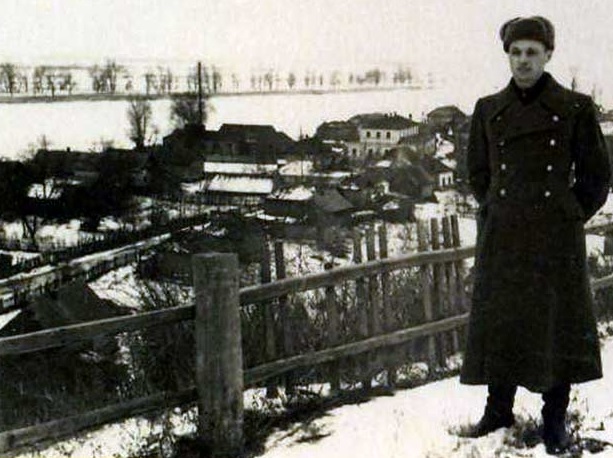
(Soviet soldier in Chernobyl after its liberation.)
Pripyat, which did not exist during WWII, was named after the Pripyat river and Pripyat marshes region around Chernobyl. In mainstream literature this is often incorrectly conflated with WWII’s Pripet Marshes Campaign, which was fought about 65 – 100 miles northwest and not part of the Chernobyl battle.
Chernobyl was declared fully free of UXO and land mines in early 1954, 8½ years after the end of WWII in Europe. This timeframe was not unusual due to the massive areas the Soviet army had to clear after WWII.

(Chernobyl in 1946, a year after WWII ended. A barge is being used as a makeshift bridge.) (photo by Anatoliy Besedin)
During the 1986 cleanup operation, there were no known incidents of liquidators being injured by leftover WWII mines or UXO, however articles such as belt buckles, knives, stahlhelms, etc were found as the pits to bury radioactive waste were dug. These remains of WWII were immediately reburied with the remains of the new catastrophe as it was forbidden to take anything out of the exclusion area.

(The Great Patriotic War (WWII) monument in Tolstoyy Les. This town was 5 miles west of the power plant and in the “Red Forest plume”, so named as the radiation was so strong, it killed chlorophyll cells in trees turning them from green to rust-colored in 1986. Tolstoyy Les was abandoned and partially demolished but the statute of a soldier with PPSh-41 remains. Moss and lichens in the exclusion zone are especially dangerous as they constantly draw radioactivity from surfaces and concentrate it.)
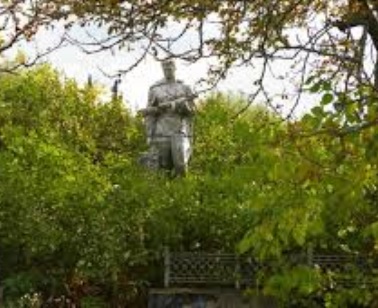
(Chistogalovka was a rural village 1¾ miles southwest of the power plant. The Great Patriotic War monument here is actually a tombstone on a mass grave of Soviet soldiers who fell in 1943. Now fading into the forest, it is the last remaining piece of Chistogalovka as the rest of the radioactive village was buried in 1986.)
WWII did have one more effect on the 1986 accident cleanup. The new town of Zeleny Mys was constructed during the autumn of 1986 outside the most-contaminated “inner zone” (then loosely drawn to exclude 40 curies per 250 acres areas, usually 19 miles away from the power plant) to house displaced civilians from Pripyat. Construction of Zeleny Mys was repeatedly delayed as WWII land mines were unearthed. Elimination of the ordnance did not help much, as Zeleny Mys was a “masterpiece” of late-1980s Soviet planning with botched buildings not to code and lousy streets and sewers. Few evacuees ended up staying there.
ISU-152: basic description
Weighing 47¼ tons, the ISU-152 was 30’1″ long, 10’1″ wide and 8’2″ tall. It had a crew of 5: commander, driver, “lockman” (operator of the gun’s breechblock), gunner, and loader. All sat in a heavily-armored blockhouse structure, separated by a steel firewall from the propulsive components behind them.

Although it is often described as a tank destroyer (a mission it could certainly fill), the ISU-152’s “assault gun” concept was to lead attacks by eliminating German anti-tank guns and field artillery with direct fire, and operating as a howitzer to break up reinforcements or retreats. Meanwhile the anti-masonry round could be used against pillboxes, bunkers, or city buildings.
The main feature was of course the massive ML-20S 152mm gun. This was nearly identical to the ML-20 towed artillery piece. In the indirect fire role, it allowed the ISU-152 to shoot 10 miles as a howitzer. In the direct fire role, ranges of up to 4,000 yards were possible as an anti-tank gun.

(ISU-152 near the power plant in 2015, showing the size of the ML-20S and its substantial muzzle brake.)
There were several types of ammunition: the OF-540Zh (HE Frag), 53-BR-540 (anti-tank), S1 (illumination), ZHZ (nerve gas), and 53-G-545 (anti-masonry). Only 20 shells were carried. In use during WWII, it was found that other than the heaviest German armor, the HE round was often sufficient to destroy a tank by brute explosion. Soviet crews sometimes filled the vehicle with these and stowed anti-tank and other types externally on the engine compartment; if enemy bullets cooked them off the ISU-152’s armor was sufficient to protect the crew anyways.
Like anything in war the ISU-152 was not perfect. Many WWII armored vehicles were not fast by modern standards, but the ISU-152 was particularly a sloth with a maximum speed of 19mph on paved highways and as little as 8mph in mud. Like all casemate-style vehicles, the main gun had limited traverse (just ±10° off centreline) and beyond that the whole vehicle had to turn to aim. This could put the ISU-152 at risk of being outflanked, and for that they often operated paired in a ∧ formation. Prior to the upgrades described below, there was no secondary armament. (The crew was provided with PPSh-41 submachine guns however.) The biggest handicap was simply the size of the ammunition. Twenty rounds was too little and it took between 45 minutes to 1 hour of hard labor to load twenty into the vehicle.
Overall this was a very successful vehicle during WWII, with the ISU-152 playing notable parts in the Lviv counteroffensive, the East Prussia campaign, and the final battle in Berlin. Soviet crews called it “Beastslayer” because it could destroy the King Tiger, Panther, and Elefant.

(Test firing of the ISU-152’s 53-BR-540 anti-tank round against a Panther hull recovered from a battlefield during WWII.)

(A Sd.Kfz. 166 Brummbär destroyed by a ISU-152 during WWII.)
Of particular interest is the anti-masonry round developed during WWII. The 123 lbs 53-G-545 shell (1,811fps muzzle velocity) was designed to “smoosh” against a concrete face instead of ricocheting or splitting, and then direct the force of it’s 9½ lbs explosive all directly forward. Rebarred concrete 3′ thick could be defeated. This shell would end up being the reason ISU-152s were called out of retirement in 1986.
the ISU-152 after WWII
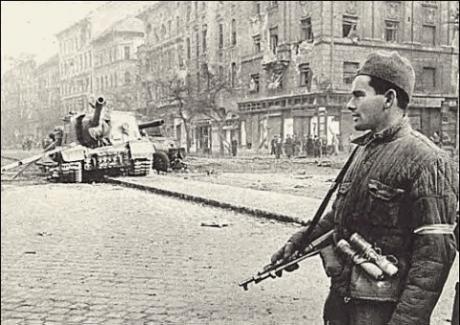
(A Hungarian freedom fighter near a pair of knocked-out Soviet ISU-152s during the failed 1956 uprising.)
The vast majority of these vehicles built during WWII survived the conflict. The Soviet Union later exported some to Czechoslovakia, Poland, and Romania in Europe; China and North Korea in the orient, and Egypt in the middle east.

(Czechoslovak ISU-152 on parade.)
The Soviet army itself used the ISU-152 long after WWII and there were three upgrade programs:
The “ad hoc” effort started in the late 1940s and ran through the late 1950s for ISU-152s not receiving one of the other two upgrades. It added a DShK AA gun and some of the improvements below, but not all, varying from vehicle to vehicle.

(Upgraded ISU-152 with DShK, additional external fuel, and an unditching log.)
ISU-152K: Done by the Kirov Zavod in Leningrad during the mid-1950s, this substituted the V-54K diesel engine and cooling system of the then-new T-54/55 tank and transmission of the T-10 heavy tank. The internal ammunition was increased to 30 rounds by substituting external fuel tanks for the one inside the fighting compartment, which also increased crew safety. A new commander’s copula was installed, with a DShK AA gun and the radio was upgraded. The most apparent visual trait was a ½”-thick “eyebrow” of added armor welded onto the already-thick mantlet.
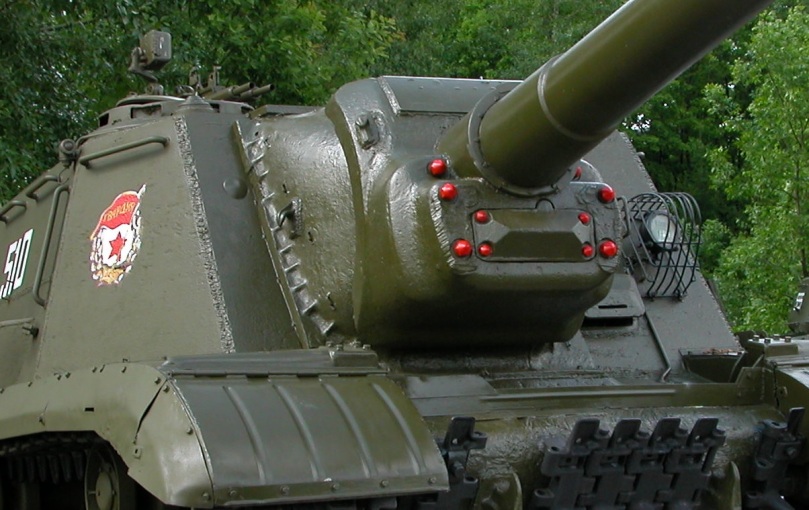
(ISU-152K upgrade showing the “eyebrow” of added armor.)
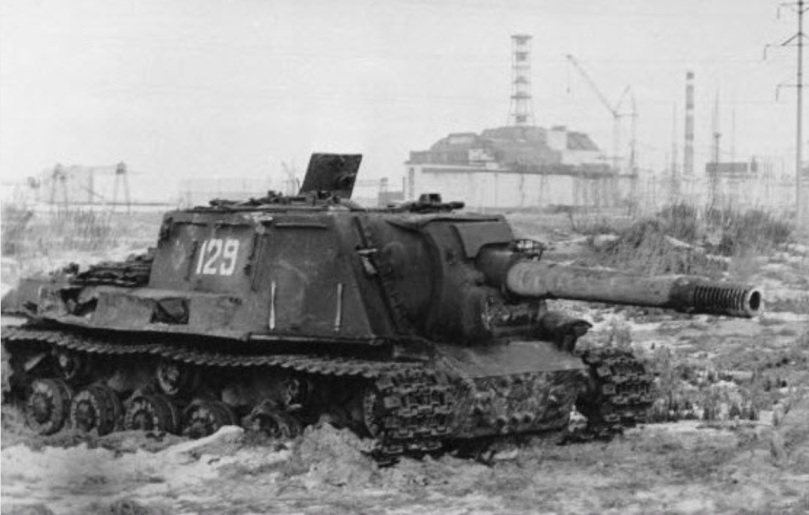
(This ISU-152K was a liquidator vehicle. The photo was probably taken in late autumn 1986 as construction of the Sarcophagus over the destroyed reactor 4 in the background was concluding.)
ISU-152M: Done in 1959 at the Chelyabinsk tank factory, this had all the ISU-152K features except for the new cooling system and armor “eyebrow”, but, also added night-vision gear.

(Two ISU-152Ms come ashore from the amphibious assault ship Voronezhskiy Komsomolets during the late 1960s.) (photo via tanks-encyclopedia website)
ISU-152s served in the Soviet army officially until 1974, however they continued in low-scale use after that. For example a unit of the KGB Border Guard along the Soviet-Afghan border had a “de-gunned” ISU-152 as late as 1984. Others were in “Category III” or “Arsenal” divisions, low-readiness units, in the 1980s.
During the Yom Kippur War in 1973, the Egyptian army still operated about three dozen ISU-152s. Prior to the “Badr” operation (the crossing of the Suez Canal), ISU-152s were used as semi-stationary pillboxes on the canal’s African bank, dueling with Israeli artillery on the Sinai bank of the canal. They fared more poorly in the open Sinai desert and were discarded after the conflict.

(Egyptian ISU-152 dug in along the Suez Canal in 1973.)
Iraq received an ISU-152 regiment – about 30 vehicles – being the final “new” user, three and a half decades after WWII. Their origin is uncertain; it was suggested that they were third-hand from China but they may have come from the USSR. They saw combat against Iran in the early 1980s where little was said of their performance. At least one was still extant (but non-operational) during the 2003 American invasion.
the ISU-152s at the reactor
Outside of the then-Soviet Union the first outside knowledge of ISU-152s being used at Chernobyl came in the 1990s after Ukraine’s independence. At the beginning, it was thought that maybe one hulk had been left in the area from WWII and was coincidental to the 1986 disaster. Later, additional sources provided the nearly unbelievable reasons for the presence of these aged vehicles: the Russian book Chernobyl Notebook by Grigory Medvedev, another Russian book called Chernobyl: Undeclared War, and features in Military Review and Krylya Rodiny magazines amongst other sources.
where they came from
The exact number of ISU-152s used in the disaster cleanup is not certain, with eleven being the high limit quoted. For certain, there were at least three and probably four.
The ISU-152s at Chernobyl were drawn from the 22nd Guards & Red Banner Tank Division, based at Volonye Barracks near Novomoskovsk, Ukraine. This base is 293 miles southeast of the power plant but about 390 highway-miles; roughly a 10½ hour trip for a tank transporter truck. In 1986, the 22nd Division was a Category III unit of the 6th Guards Tank Army meaning it had gear not all of the current generation (it was a T-64 operator in the late 1980s) and only manned 10% – 25% during peacetime. Category III divisions also tended to be the last stop for woefully obsolete vehicles before Arsenal Category (warehouse lay-up) units or the scrapyard, so it’s not unreasonable that the 22nd had WWII equipment on hand.
For those who may wonder why the numbers on the WWII-vintage ISU-152s around the power plant can not be back-traced to determine their previous histories; requires an understanding of how Soviet armored vehicles were numbered in the 1980s.
The numbers on tanks, assault guns, APCs, etc were called bort numbers. Directly translating as “board”, bort can also be understood to mean “the side”. The first digit indicated which battalion of the regiment the vehicle belonged to. The second was which company in that battalion. The third (and fourth if needed) was a random sequential count of that company’s vehicles. For example, an assault gun “326” was the sixth vehicle in the 2nd Company of the 3rd Battalion. Bort numbers changed whenever a vehicle was reassigned, or when the battalion’s and/or company’s strength grew or decreased, or at the battalion commander’s discretion.

(By 2015, the camouflage on the ISU-152 parked near the power plant had faded away revealing previous bort numbers underneath 100, which it wore during the 1986 catastrophe.)
At Chernobyl in 1986, the basically meaningless bort numbers can still be used as a reference for the specific vehicles: #100 (probably the most famous one now), #129, #130, and the unknown-number fourth vehicle, if it existed.
A fair question is why three (or four, or more) ISU-152s ended up in the exclusion zone when the original mission (as described in the next section) only required one. Barring more information becoming available, there is no clear answer. It may have been that when an odd request for an old WWII vehicle was received in 1986 with no explanation as to why or for what (the nuclear accident was originally treated as a state security matter), the tank division at Novomoskovsk decided on its own to send as many as it had.

(As there would obviously be no combat, the ISU-152s at Chernobyl usually operated with two or three liquidators: commander, driver, and sometimes a third man to constantly watch a radiation dosimeter.)
ISU-152: the mission in 1986
1) the “holing” mission
This was the reason the old WWII ISU-152s were brought to the disaster to begin with.
Underneath the destroyed reactor was a basement intended to trap small amounts of steam and bubble it through another floor containing a bubbling pool. The accident filled both levels with firefighting water, creating a steam explosion hazard. Barring that, it was possible the molten uranium fuel could completely exit the structure and burn down into the groundwater table. The original plan to address this was to pierce the building’s outer wall and insert a pipe through which liquid nitrogen would be pumped, freezing everything.
To cut the hole in the wall with concrete saws would result in unacceptably long exposure to workers. Instead it was hoped that the ISU-152, with its heavy glacis armor serving as a radiation shield, could approach reasonably close and fire a 53-G-545 anti-masonry round to hole the wall.
A similar wall was located and the concept was tested by a ISU-152. The hole caused by the test-fire hit was too small for the planned pipe, and multiple rounds would risk causing a section of wall to collapse which would cause immeasurably worse problems. The idea was dropped. Instead, miners dug a tunnel underneath the reactor. In the end, the liquid nitrogen idea was abandoned altogether.
2) demolition jobs
The ISU-152s were instead used to demolish buildings. There was nothing in the WWII design that made them suitable for this task, other than that they were tremendously heavy tracked vehicles, and, that they were now already there. Bulldozers and backhoes had to be flatbedded in, and there was limited heavy trucking bandwidth. To simply flatten a small building did not require the finesse of construction vehicles, so the ISU-152s were selected.

why this was done
The demolition is often ascribed to preventing evacuated civilians from returning to the exclusion zone. This was maybe a part of it, but the real reason was radiation.
Other than highly-mobile dust, radioactivity in wood remains “captive” unless disturbed. However burning radioactive wood makes the captive contamination mobile again, to be released through particles in smoke and ashes blown by wind. As there would never be anybody to put out fires started by lightning, etc over the decades to come, this would present an ongoing issue.
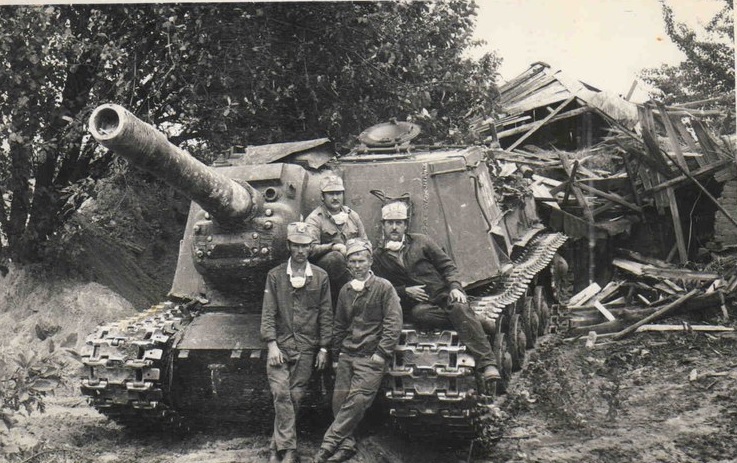
(The liquidator ISU-152s had the sheet steel running guards cut away so the tracks could be more easily cleaned of radioactive mud.)

In Pripyat, some minor outbuildings around the power plant itself were knocked down to widen access to the destroyed reactor so the Sarcophagus structure could be built. Construction of this started in June 1986 and was completed in November.

The flattened buildings were pushed into trenches called by their Russian acronym PVLRV (Point for Temporary Localization of Radioactive Waste). The debris, often with nearby cut-down trees and sometimes with the demolition vehicles themselves, were then buried and topped with a sprayed plasticizer. Today PVLRVs can be seen as slightly raised mounds without trees, as seedlings can not penetrate the plastic caps. Usually there is just a simple tin radiation symbol sign, with no description of what was buried.
There are about 800 known PVLRVs in the exclusion zones of modern Ukraine and Belarus. They contain the debris of buildings (some have entire rural villages) and an unknown number of vehicles. Some vehicles, including the fire trucks which first responded in the early hours of 26 April 1986, were so radioactive that they were shoved directly into PVLRVs without being further touched. Civilian vehicles left behind in Pripyat and the nearby town of Yaniv were also pushed directly into PVLRVs. Nobody knows for sure exactly how many PVLRVs exist, because in the early days of the cleanup they were created in a hurry, sometimes on-the-spot, and not properly logged.

(This PVLRV covers what had been the village of Kopachi.)
As mentioned earlier, there was nothing specific about a WWII-vintage ISU-152 that made it ideal for the demolition task, other than that they had already been brought into the area for the aborted concrete-shooting job and could certainly run over a lot of things.
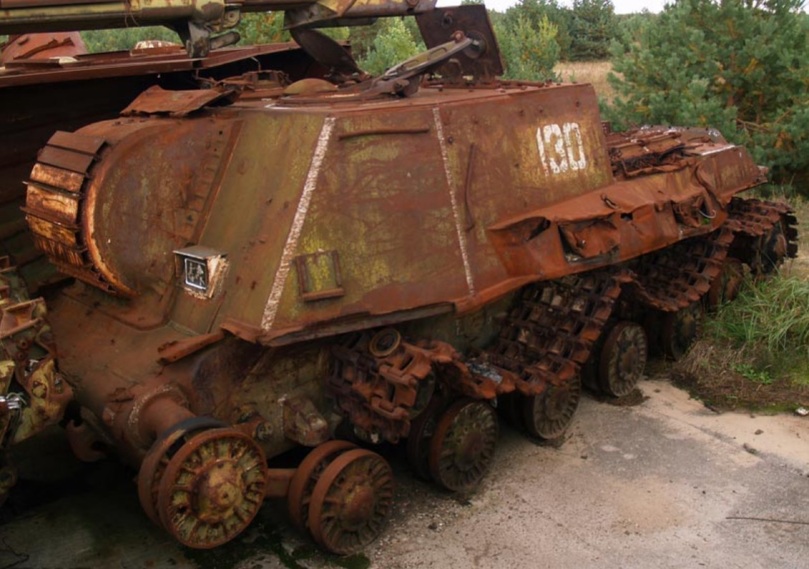
(The ML-20S was irrelevant to the demolition task and not only was the barrel no help, it often became a hindrance. This ISU-152, bort #130, eventually had its gun removed. The embrasure was plugged with a lead slab and then angle irons were welded over that as reinforcement. This ISU-152 also had the WWII driver’s vision port replaced by a piece of radiology glass.)
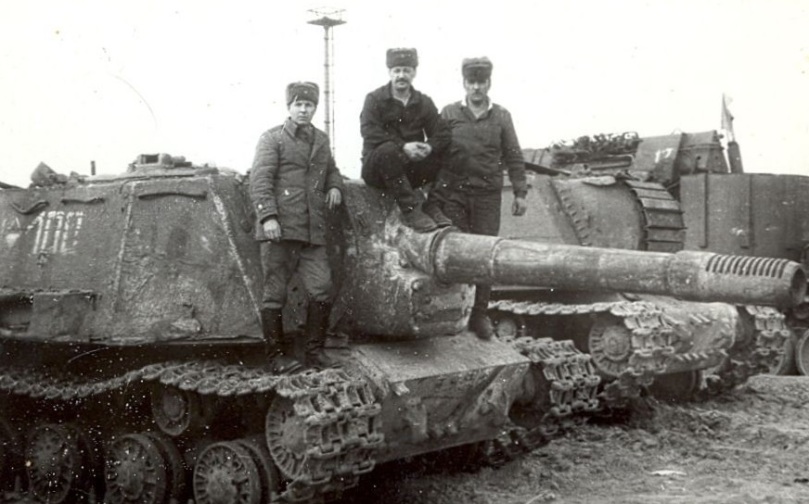
(The modified #130 alongside #100 which retained its ML-20S.) (photo via vaplakal.com website)

(A close-up of the new window. Radiology glass has a yellowish tint as lead powder is added to molten glass during blowing.)
•Misidentified or odd vehicles in the zone•
Other abandoned hardware in the exclusion zone has incorrectly been described in various media as “WWII gear”. In fact, other than the ISU-152s, there was only one single other WWII-era vehicle known to be used, a BTS-4-44M turretless tow vehicle conversion of a T-44 tank. No photos of it in use in 1986 are known.
Below are some of the commonly misidentified vehicles and their true identity, and one ironic non-WWII item.
the “other tank destroyer”
Despite its appearance, this vehicle (of which one was known to have been used in the cleanup) is neither another ISU-152, nor is it another WWII assault gun, nor is it a WWII vehicle at all.

This is a BMR-1 mineclearer. During the 1980s Afghanistan war, the Soviet army relied on plows fitted to tank for clearing land mines. A more specialized vehicle was desired, so a small number of SU-122-54 tank destroyers (a Cold War design) were modified. In 1986, one BMR-1 was modified with the mine warfare kit removed and a cocoon of lead fitted under a makeshift steel frame.
the “WWII truck”
The below vehicle is often cited in the mainstream media as a “WWII truck in Chernobyl”.

This is actually a (very early) post-WWII truck, the ZiS- / ZiL-151. During WWII, a main logistics asset of the Soviet army was Lend-Leased Studabaker G630 trucks. At the end of the 1945 Manchurian campaign, the USA abruptly ended Lend-Lease to the USSR, including spare parts, and the Soviets began design of a replacement. The ZiS-151 entered production in 1948. In 1956, as part of Nikita Krushchev’s “destalinization” effort, the Stalin Zavod factory was renamed and the prefix of this truck, with others, was retroactively changed from ZiS (Factory of Stalin) to ZiL (Likacheva Factory). The ZiL-151 remained in production until 1966 and examples were still in the Soviet military in 1986.
The logo on the truck’s door says “zone” in Russian. This was to alert MPs directing traffic that the vehicle was forbidden to leave the contaminated area. This doomed truck is apparently of post-1956 manufacture as the hood ornament is ZiL.
the “Duck”
The vehicle below is sometimes incorrectly described as a WWII Lend-Leased DUKW, aka “Duck”. The amphibious DUKW was manufactured by Pontiac, Yellow, and Chevrolet during WWII and some were supplied to the Soviets.
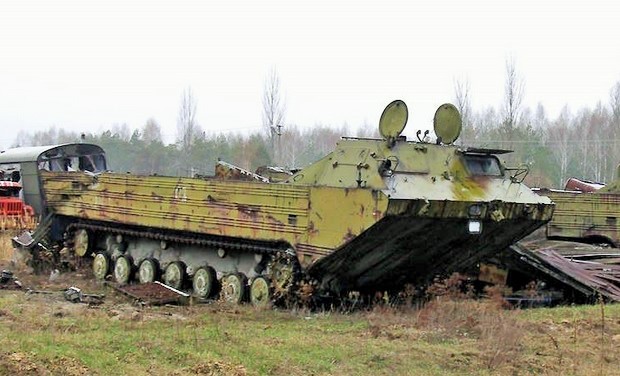
This vehicle is actually a Soviet PTS-2 amphibian. Much larger than the DUKW of WWII, PTS-2s were built in the 1960s and early 1970s. They were essentially barges that could be driven on land, with a 30′ cargo hold that could accommodate not only infantry, but even artillery pieces and small land vehicles. In Cold War-era Soviet doctrine, PTS-2s were intended to ferry advancing forces across big rivers or lakes.
The reason these were used in the Chernobyl cleanup was not their amphibious capability but rather their spacious cargo hold. Bulk removal of severely radioactive material was typically done by heavy machines and dump trucks, however, there were many tons of small things that were realistically too little for an end loader or crane to pick up. This material was gathered by hand shovels, put into regular civilian garbage cans, and then loaded into the PTS-2’s big cargo bay until it was full. The PTS-2 then drove to a burial site, dumped it, and came back for the next load of cans. The PTS-2s were modified with a lead slab inbetween the cargo bay and cab.

For reference, the above photo shows an American WWII DUKW and to the right, Lend-Leased DUKWs in the 2nd annual Leningrad Victory Parade in 1947. Like many Lend-Leased items, Stalin saw no benefit to returning them to the USA or paying for them, and DUKWs served on in the post-WWII Soviet military. However the DUKW is clearly much smaller than a PTS-2 and wheeled, not tracked.
As of 2019 there are still three PTS-2s in the area, all radioactive, one of which has now been stuffed full of helicopter engines themselves made radioactive by flying over the power plant in 1986.
the Dornier robot
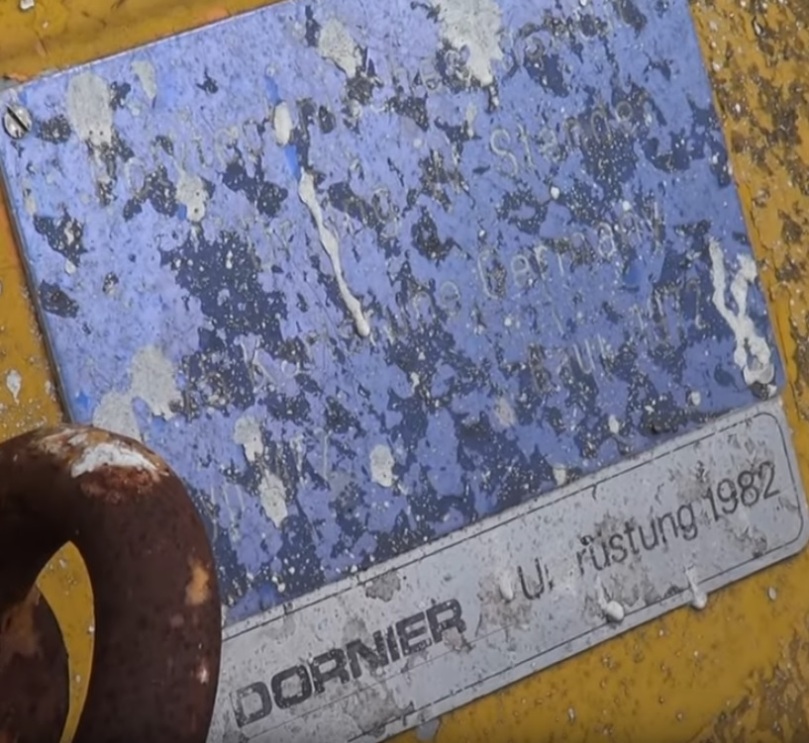
Obviously not of WWII, this never the less interesting find in a vehicle graveyard was one of several robots West Germany provided in the early stages of the disaster. During WWII, Dornier Flugzeugwerke made some of the Luftwaffe types used on the Ostfront, including the Do-17 and Do-217 bombers and Do-24 seaplane. After WWII, during the interim when West Germany was still banned from warplane construction, the successor company Dornier GmbH briefly made civilian cars before later branching back into aerospace, robotics, and land transport systems.

(Dornier Do-17 bomber in occupied Russia, 1941.)
In the 1980s USSR, animus towards West Germany was encouraged by the communist party as a supposed continuation of the Third Reich in deference to the Soviet Union’s ally, East Germany. Naturally the specialist gear provided by West Germany in 1986 was not highlighted at the time – especially equipment from a company which once armed the Third Reich – and was a source of shame to those who knew about it, as the relevant gear could not be sourced anywhere in the communist world.

(Another West German product, the Putzmeister “spider-leg” concrete pumper critical to building the Sarcophagus was made by MAN, which during WWII had built PzKpfw. V Panther tanks.)
the “old tank”

Based on its archaic-looking appearance, this vehicle was sometimes described as “a converted WWII light tank”. Actually it was a DET-250 bulldozer with the rear hydraulics removed, and the cab massively modified with slabs of lead to shield against radiation. A military NBC filtration system was fitted on the roof along with floodlights.

The DET-250 was manufactured in the USSR during the 1960s and 1970s and was a common civilian type.
the “converted T-34s”
These vehicles, despite their old appearance, are not “converted T-34 hulls” as sometimes cited but rather a specialist combat engineering vehicle called the BAT-M.

The BAT-M is a modification of the BAT, itself a modification of the AT-T artillery tractor which entered service two years after WWII ended. Some of the BAT-M’s features, including the “starfish”-style roadwheels, are the same as early-1950s T-54/55 tanks and postwar-upgraded WWII T-34s. Combined with the vehicle’s antiquated look, this probably led to the confusion by sources unfamiliar with combat engineering hardware.

BAT-Ms were tremendously useful after the 1986 disaster and many were sent there, never to leave.
Final fate of the ISU-152s at Chernobyl
There were initially about a dozen vehicle graveyards total in what is today northern Ukraine and southern Belarus. Of these, most were small, one (a nameless one in Pripyat) could be described as medium-sized, and two were large: Buryakivka (also transliterated as Byryakivka), 8,400 yards due west of the plant; and Rossokha, about 9 miles southwest of the city of Chernobyl. These yards were known by their Russian acronym, PZRO, or Point of Radioactive Waste Burial.

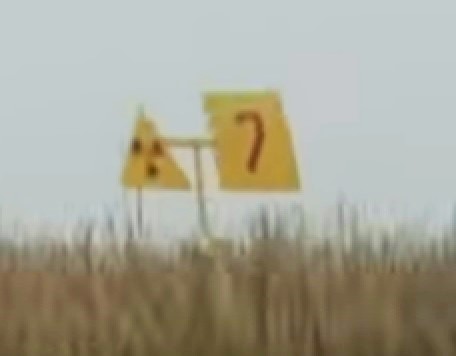
(Clay-lined burial pits at the Buryakivka PZRO; during the 1980s and how they are marked today.)
The Buryakivka PZRO sat on an area directly downwind of the power plant and already massively radioactive, and was adjacent to what had been the main east-west highway between Pripyat and Ovruch.
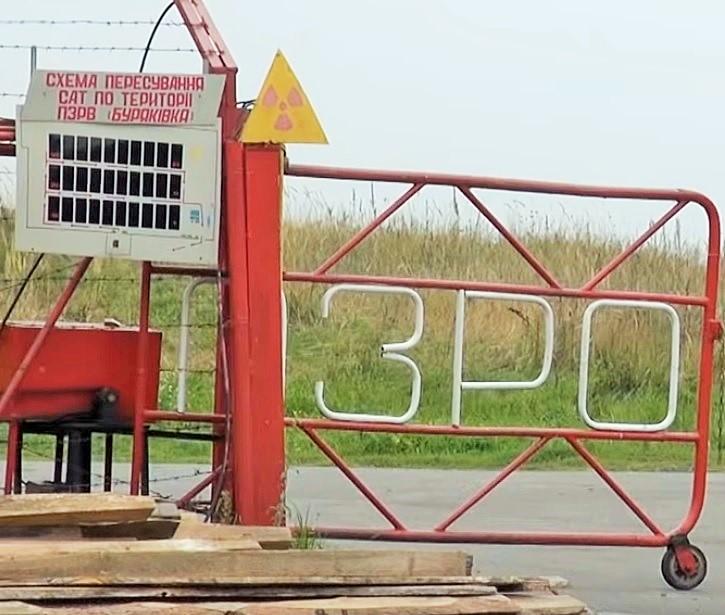
(The entrance to Buryakivka today. The gate says PZRO in Russian.)
The Rossokha PZRO was formerly a Young Communists summer campground. At its peak, a total of 1,610 vehicles were here. Today in 2019, the former site is an empty field about 2 miles northeast of the Stary Sokoli checkpoint on the exclusion zone’s southern limit.


(Entrance to the now-empty Rossokha PZRO.)
Buryakivka has always been in the “inner zone” (40 curies per 250 acres areas or more), while Rossokha sat just on the line of the original “inner” and “second” (5 to 15 curies per 250 acres) zone. In the latest (2018) Ukrainian change to the way the exclusion area is administered, both are in the exclusion area while Buryakivka is also in the “10km Zone” which requires additional permissions to enter. To actually get permission to enter a PZRO itself (which are patrolled by the military) requires another permit or membership in a licensed tourism group.
As might be imagined by the name, PZROs were envisioned to be giant burial sites of vehicles, in the same way that bulldozed abandoned towns were handled: a spot slightly above grade if possible would be excavated, filled with radioactive vehicles, and then covered with soil and topped with either a plasticizer or concrete. It was not intended to store vehicles above-ground, however the sheer number of contaminated vehicles made this necessary. When the Soviet Union collapsed in 1991, 10 million tons of vehicles and other debris had been buried but there was still an estimated 11 million tons to go. At Buryakivka, by 1999, 27 of the 30 clay pits (which are 12′ deep and the size of an Olympic swimming pool) were already full.
liquidating the liquidator vehicles
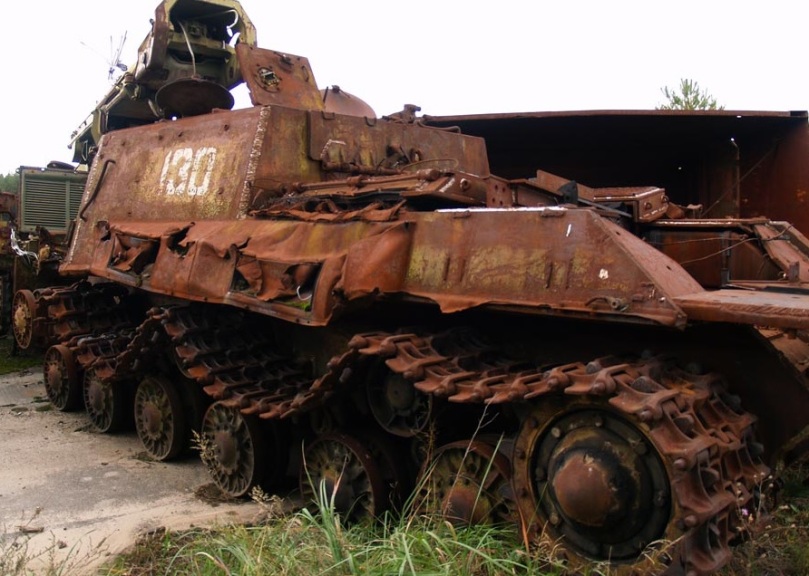
(ISU-152 #130, the de-gunned example, laying derelict and stripped in the late 2000s.) (photo via lplaces.com website)
In photos of the PZROs from the 1990s and 2000s, many of the vehicles looked stripped. This is in large part to rampant theft of radioactive parts, especially in the first few years of Ukraine’s independence in December 1991. Often this was things that could be quickly resold for civilian use, like “Twelve-Twenty”-size tires common in the former USSR, starter motors, heater cores, alternators, copper wiring, etc.

(These LAZ-695 civilian busses today rest near the ISU-152 #100 in Pripyat. A tremendous number of busses were involved in the Chernobyl cleanup: a convoy of 1,100 busses evacuated the zone in 1986, and thereafter, a fleet transported liquidators inside the outer zone of the exclusion area, where passengers moved to another bus fleet confined to the inner zone.)
Some of the stripping (but, probably, not much) was intentional. After the initial 1986 – 1987 “surge”, the USSR sought to throttle down the stream of expensive military vehicles being lost to the Chernobyl black hole, and broken-down contaminated vehicles were repaired inside the exclusion zone by taking spare parts off other radioactive vehicles whenever possible.
Prevention of theft from the exclusion zone has always been a major problem. Vehicles are by no means the only target; already by the end of the 1980s thieves had picked clean the homes of evacuated Pripyat for furniture, radios, and anything else of value.
During the 1990s, some of the smaller collection points were consolidated into Buryakivka and Rossokha. In 2006, Ukraine partially relaxed the total ban on removing vehicles from the zone which had been in place since 1986; in a bid to clear out some very low- or non-radioactive hulks. That same year, the vehicles at Rossokha started to be cut down into smaller pieces, with some of them being sent to Buryakivka.

(ISU-152 bort #130. Judging by the downwards gash it appears somebody was mid-job of torching through the side armor.)
In 2012, Ukraine made a decision to completely dispose of all the vehicles. To do this, they were first broken apart at the PZROs. The pieces were then dispensated:
♦Pieces still severely radioactive were simply compacted and buried on site.
♦Some strongly radioactive pieces would be treated by an acid bath, which removed the outer layers. This resulted in both the remaining metal and used acid being low-level waste, which could be then either compacted and buried, or, released into the civilian scrap metal stream where it would presumably be diluted away into uncontaminated scrap after recycling.
♦Pieces with little or no contamination would just be recycled as-is.
The degree to which this plan was actually followed is debatable. There seems to be a deficit between the hundreds of affected vehicles, and seemingly lesser amounts which was treated and/or buried. Some pieces were reportedly buried at the PZROs themselves but the most likely seeming alternative is that the plan was ignored, and some vehicles just released into the scrap metal market as-is.
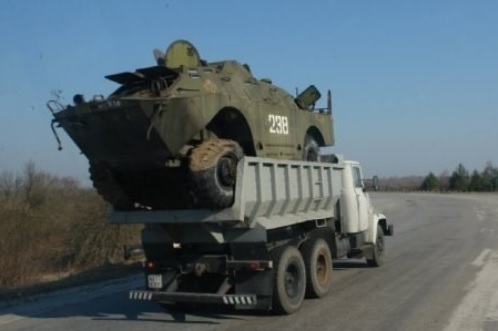
(Abandoned Cold War-era BRDM-2 armored cars are tremendously common in the exclusion area, as they were designed from the start to fight NATO on a radioactive battlefield and the Soviet military had lots of them in 1986.)
The Rossokha PZRO issued its last bimonthly vehicle count in December 2012. By late 2015, Rossokha was empty of intact vehicles and by 2019 was just a storage site for piles of cut-up scrap metal. By 2020, Buryakivka will be cleaned out as well; in September 2019 roughly 9 out of 10 of the vehicles there were already either cut up, buried, or had simply vanished.
of the ISU-152s:
#129: This ISU-152 was for some time after the cleanup, stored near the Jupiter radio factory in Pripyat. It was apparently moved at a later date, either to one of the two PZROs or just buried.
#130: This ISU-152 was stored first at Rossokha and then at Buryakivka. It was still extant as late as 2016; the current (2019) status is unknown.
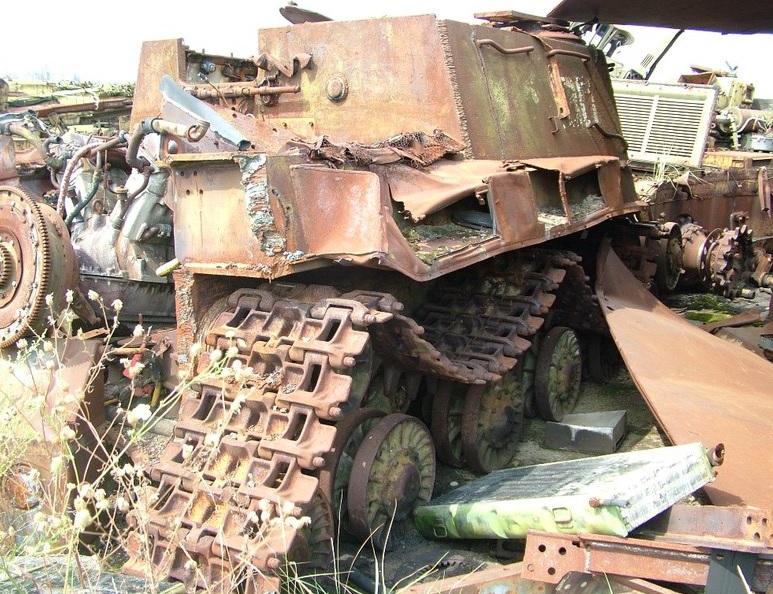
The unknown bort number: If this fourth ISU-152 was not a double-counting of one of the other three, it was not seen again after the immediate clean-up period in 1986 and may have been buried in a PVLRV early on.
#100: The most famous of the bunch, this one is parked next to Novarka, the company in charge of the New Safe Containment (NSC) which was built in the 2000s and wheeled over the Sarcophagus in November 2016. This facility, basically just a warehouse, was once the fossil fuel subfacility of the atomic power plant. It is located just northeast of the power plant, as shown.
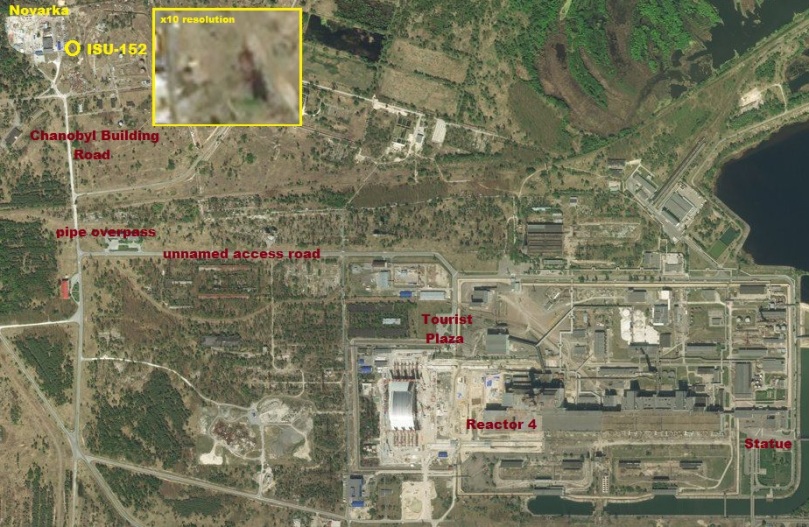
(2015 image via Bing)
The ISU-152 is parked by itself next to a concrete panel wall. It is unclear why it was left in this location; it is possible that the vehicle had a mechanical breakdown in 1986. By the early 2000s it was gutted, with all the internal furnishings and most of the propulsive components ripped out.

(The ISU-152 bort #100 in 2018.)
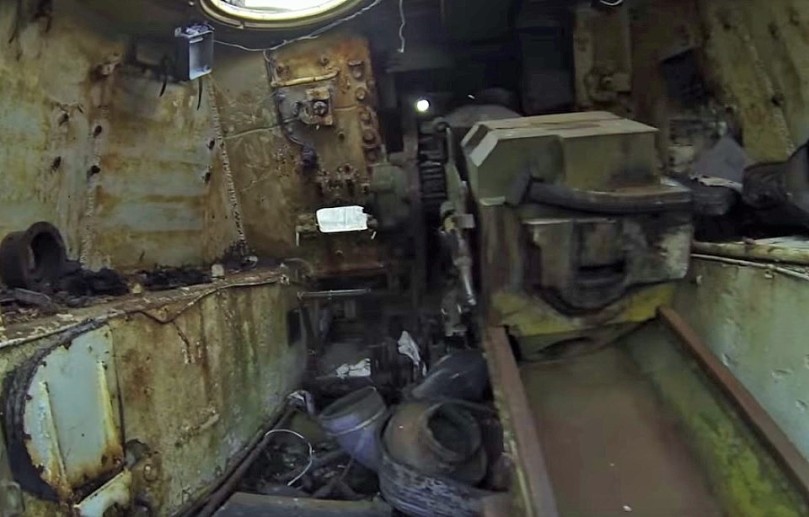
(The interior of the vehicle in 2015, with pretty much everything stripped out.)

(By comparison, the WWII appearance. Note the PPSh drum mags on the rack above the gun, in case the crew had to fight dismounted.)

(The gutted engine compartment during the summer of 2015.)
Regarding the radioactivity of this ISU-152, as of 2018 it ranged from 80 μR – 110 μR /hr (0.71 μSv – 1 μSv) on the glacis, gun barrel, and side armor. However this is not uniform across the vehicle. Parts of the underside of the treads measured 449 μR /hr (3.94 μSv), this because the flat upper parts of the vehicle more exposed to weather allow rain to slowly wash some of the radioactivity off into the surrounding ground as the ISU-152 rusts, while more concealed areas do not readily do so.
By comparison, the “Pripyat Soup Ladle”, a crane claw used in 1986 – 1987 and generally regarded as the most radioactive vehicular item, measured as high as 80 mR /hr (702 μSv or 80,046 μR /hr) in 2018. The most contaminated place outside of the Sarcophagus in 2018 was a basement in Pripyat that measured 0.3 R /hr (2,631 μSv or 300,000 μR /hr).

As a point of reference, normal background radiation in New York City in 2019 is 0.9 μR /hr (0.00868 μSv).
postscript
In 1998, Ukraine allowed the first private visitors into the exclusion zone and in 2008, began tour group expeditions. In 2015, regularly-scheduled tours began (including visiting the power plant itself which finally shut down the surviving reactors in December 2000) and in 2018 thousands of visitors came. By 2019 a tour of the exclusion area had become something of an internet cliche and there was growing displeasure in Ukraine and Russia at how the area is being treated as a “fun” time.

The ISU-152 #100 remains next to the Novarka facility as of September 2019 but it is becoming an annoyance due to tourists breaking off from groups trying to find the WWII vehicle. There is also a concern of a thrown cigarette, etc starting a grass fire. Besides the aforementioned problems with fire and captive radiation, the ISU-152 sits underneath a newly-run power line – an irony being that the closed power plant, which once provided a tenth of all the USSR’s electricity west of the Urals, is now today an electricity consumer.
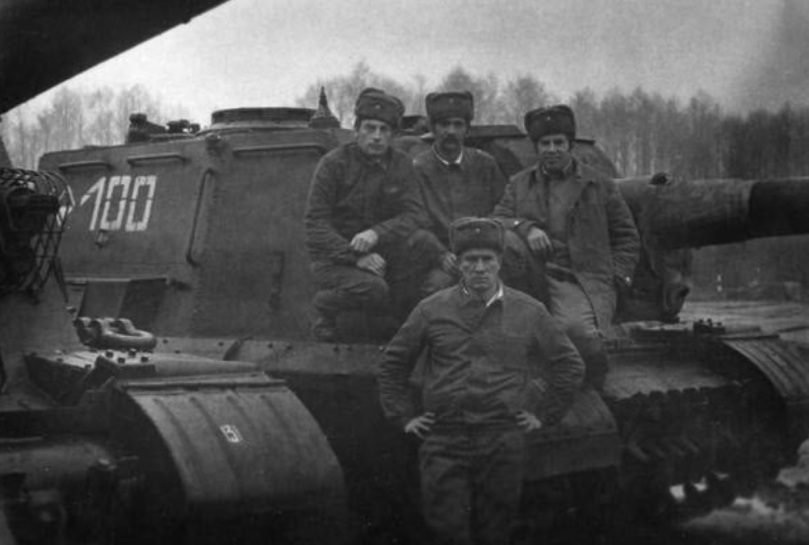
(courage of the liquidators 1986)

really really interesting love the story and the history sad them cut them up you know a historical tank with an even bigger part added to them but i guess a radioactive tank isn’t the best thing to have in your museum thank you for being this to the light 🙂
LikeLiked by 1 person
Because this is perhaps the right blog to ask, can you by any chance explain this picture?

How exactly did a military like Ghana’s get it’s hand on Type 96/99 LMGs considering how quickly most imperial japanese weapons disappeared after the war?
LikeLike
My guess is that it is a historical WWII display at the museum, as Ghanian soldiers fought under British control against Japan during WWII. They were not Ghanian service weapons.
LikeLike
Ghana / Gold Coat Africa soldiers fought in the Burma campaign against Japanese and probably brought back the guns in some sort of orgained fashion.
https://en.m.wikipedia.org/wiki/82nd_(West_Africa)_Division
https://www.aljazeera.com/photo_galleries/programmes/2011829151520656815.html
LikeLike
What a great article, thank you.
LikeLiked by 1 person
Thank you, good article!
LikeLiked by 1 person
Fascinating read.
LikeLiked by 1 person